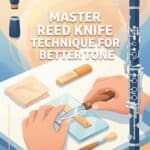Clarinet reeds evolved from hand-carved cane blades to precision-profiled cane and synthetic materials; key milestones include 19th-century cut experimentation, 20th-century synthetic introductions, and modern CNC profiling that improves consistency, durability, and tonal options. These changes give clarinetists finer control over tone color, response, and reliability across climates and genres.
Introduction: Why the Evolution of Clarinet Reeds Matters
Clarinet reeds sit at the intersection of history, acoustics, and daily practice. A tiny change in thickness or material can transform response, pitch stability, and color. Understanding how clarinet reeds evolved, how they are built, and how they behave lets advanced players and makers solve problems systematically instead of guessing between boxes and brands.
For teachers, reed knowledge explains student issues that look like embouchure faults but start at the tip of the reed. For luthiers and mouthpiece makers, reed behavior informs facing curves and chamber designs. For historians, reed development mirrors trade routes, industrialization, and changing musical tastes from the 18th century through the present.
Reed lifespan data: Typical cane clarinet reeds last about 15-30 playing hours in moderate humidity, compared with 80-150 hours for many synthetic models, assuming proper rotation and storage.
A Concise Timeline of Reed Development (from cane to modern materials)
Early clarinet reeds in the late 17th and early 18th centuries were simple blades of Arundo donax cane, often cut and scraped by the player. Surviving 18th-century methods from makers in Nuremberg and Paris describe hand-split tubes, roughly planed blanks, and minimal profiling, suited to smaller bores and high pitch standards of the time.
By the early 19th century, as the clarinet gained orchestral prominence under composers like Weber and Spohr, reed cuts diversified. French makers experimented with thinner tips and longer vamps to match evolving mouthpieces and the early Boehm-system clarinets developed by Hyacinthe Klosé and Louis-Auguste Buffet around the 1830s and 1840s.
Late 19th-century catalogs from Paris, London, and Leipzig show standardized strengths and distinct “French” and “German” cuts. This period introduced machine-assisted planing and more consistent splitting of cane. Industrialization allowed larger reed factories to supply growing conservatories and military bands across Europe and North America.
In the early 20th century, reed makers refined profiling machines that could shape the vamp, heart, and tip with repeatable tapers. Between the 1920s and 1950s, brands began labeling strengths numerically, which helped teachers and students coordinate setups across regions, especially as pitch standards converged around A=440 to A=442 Hz.
Synthetic clarinet reeds appeared experimentally in the mid-20th century, with early plastic and fiber models emerging in the 1950s and 1960s. These first generations often lacked the complex overtones of cane but offered durability for marching and outdoor use. By the 1990s and 2000s, composite and polymer reeds with more cane-like response became widely accepted.
Today, CNC profiling and laser measurement allow reed makers to work to tolerances of hundredths of a millimeter. Modern reeds, both cane and synthetic, can be matched by strength, density, and cut profile far more closely than any historical period, giving clarinetists unprecedented control over consistency and style-specific setups.
Historical benchmark: By about 1880, major European reed makers commonly offered at least 3 labeled strengths. Today, many lines offer 5-7 strengths, often in 0.25 or 0.5 increments.
Materials and Anatomy of Clarinet Reeds
Most clarinet reeds are made from Arundo donax, a giant cane grass traditionally harvested in Mediterranean regions such as southern France, Spain, and Italy. The cane's long fibers, dense outer wall, and natural stiffness-to-weight ratio make it ideal for vibrating at clarinet frequencies while remaining responsive to embouchure control.
Synthetic reeds use polymers, resin-impregnated fibers, or composite materials designed to mimic the stiffness and density of cane. Some models incorporate a textured surface or variable core density to simulate cane's natural grain. These materials resist humidity swings but may emphasize different overtones compared with traditional cane.
Anatomically, a clarinet reed has several key regions. The tip is the thinnest part that vibrates most freely. Typical clarinet tip thickness ranges from about 0.08 to 0.12 mm. Small changes here strongly affect articulation, initial attack, and how easily the reed responds at soft dynamics.
Behind the tip lies the vamp, the tapered area that connects the tip to the thicker stock. The vamp length and contour influence flexibility, resistance, and how the reed balances registers. A longer vamp often yields a more flexible feel and broader color palette, while a shorter vamp can feel more focused and direct.
The heart, sometimes called the table or central spine, is the thickest central region of the vamp. It typically measures around 0.30 to 0.45 mm at its thickest point. The heart controls core tone, stability, and projection. A strong heart supports a centered sound and stable pitch, while an overly thin heart can sound spread or unstable.
The rails are the thin edges on either side of the vamp. Rails guide airflow and affect how evenly the reed seals against the mouthpiece rails. Uneven or excessively thick rails can cause response asymmetry, resistance, or chirps, especially on slurred intervals and altissimo notes.
The heel is the base of the reed where it meets the mouthpiece table. Its thickness and flatness influence how well the reed seals and how vibrations transfer to the mouthpiece. Makers carefully sand and flatten this area to avoid leaks that can masquerade as embouchure or instrument problems.
Typical dimensions: Many Bb clarinet reeds measure about 67-70 mm in length, with a tip width near 11.5-12.5 mm and a heel thickness around 2.8-3.2 mm, depending on cut and brand.
Historical Crafting Methods and Makers (including Martin Freres' legacy)
Early reed making was a player-driven craft. In the 18th and early 19th centuries, clarinetists often split cane by hand, scraped vamps with knives, and adjusted reeds daily. Surviving treatises by players such as Jean-Xavier Lefèvre describe detailed scraping patterns tailored to specific mouthpieces and instruments.
By the mid-19th century, specialized reed workshops emerged in France, Germany, and Italy. These shops supplied conservatories, military bands, and orchestras. Archival catalogs from Paris and Lyon show bundles of reeds sold by strength and model, often paired with specific clarinet systems like French Boehm or German Oehler.
Trade routes and world events shaped cane sourcing. Mediterranean cane from southern France and Spain traveled by rail and ship to reed factories across Europe. Disruptions during World War I and World War II forced some makers to experiment with alternative sources and storage methods to maintain supply for military and civilian ensembles.
Martin Freres, known primarily for its clarinets and woodwinds, operated within this ecosystem of European reed and accessory makers. Period Martin Freres catalogs from the late 19th and early 20th centuries list compatible reeds and strength recommendations for their clarinet models, reflecting close collaboration between instrument makers and reed suppliers.
Field Note – Martin Freres Archives: Archival Martin Freres sales sheets from the early 1900s reference “French-cut” reeds recommended for their Boehm-system clarinets and “stronger German profiles” for certain export markets, illustrating how regional playing styles influenced reed selection.
Hand profiling dominated until early mechanical planers appeared in the late 19th century. These devices allowed makers to rough out the vamp and heart to a consistent contour, with final scraping still done by skilled workers. This hybrid approach persisted well into the 20th century, especially for higher-end reeds favored by professionals.
By the mid-20th century, as orchestras standardized pitch and conservatory training expanded, reed makers refined their machinery and quality control. Some workshops introduced density sorting and visual grading of cane, separating tubes by diameter, wall thickness, and fiber quality before cutting blanks, which improved consistency across batches.
Modern Manufacturing: Profiling, CNC Cuts, and Synthetic Alternatives
Modern reed manufacturing combines agricultural selection, drying science, and precision machining. Cane is harvested, sun-dried, and then seasoned indoors for 1 to 3 years to stabilize moisture and reduce internal stresses. Makers then split tubes, plane the inner surface, and cut blanks to length and width before profiling.
Profiling machines shape the vamp, heart, and tip according to a template. Earlier mechanical profilers used cams and levers, while current systems often use CNC-controlled cutters. These machines can adjust thickness in increments as fine as 0.01 mm, allowing makers to create distinct models for classical, jazz, and marching applications.
Laser and optical measurement systems now check tip thickness, heart contour, and symmetry. Some factories scan each reed's profile and discard outliers before boxing. Others use density testing or resonance taps to group reeds by stiffness, improving strength labeling accuracy and reducing surprises for players.
Synthetic reeds follow a different path. Manufacturers design a core profile and material formula to approximate cane's stiffness curve. Injection molding, extrusion, or composite layup creates blanks, which are then machined or molded into final shape. Many synthetic reeds incorporate a textured or grooved surface to interact predictably with the mouthpiece table.
Modern synthetics aim to solve humidity and lifespan issues. They resist warping from rapid moisture changes and often maintain their playing characteristics for months. Some models offer “filed” and “unfiled” style profiles, echoing traditional cane cuts so players can switch with minimal embouchure adjustment.
For advanced players and makers, the key benefit of modern manufacturing is repeatability. Once you find a reed model and strength that matches your mouthpiece and embouchure, CNC profiling and quality control make it more likely that the next box will behave similarly, reducing time spent sorting and discarding.
Choosing the Right Reed: Strength, Cut, and Genre Considerations
Reed strength describes how stiff the reed feels in vibration. Common Bb clarinet strengths range from about 1.5 to 5.0, with most advanced players using 3.0 to 4.0. Actual stiffness varies by brand, so a 3.5 in one line may feel like a 3.0 or 4.0 in another, depending on cut and cane density.
Cut refers to the shape of the vamp and shoulders. Filed (or French) cut reeds have a distinct straight cut just below the vamp that removes bark along the shoulders. Unfiled (or American) cut reeds retain more bark in this area. Filed reeds often feel more flexible and responsive at the tip, while unfiled reeds can offer more resistance and core.
For classical playing on Boehm-system clarinets, many players prefer medium to medium-hard strengths with a longer vamp and strong heart. This setup supports a centered tone, stable intonation, and controlled dynamics from pianissimo to fortissimo. Paired with a medium-close facing mouthpiece, it offers refined response for orchestral and chamber work.
Jazz and commercial players often choose slightly softer reeds or more flexible cuts. A reed that vibrates more freely can facilitate bends, subtone, and brighter projection. Combined with more open mouthpieces, these reeds help produce a punchy, colorful sound suited to small-group jazz and amplified settings.
Marching band and outdoor players may favor synthetic or slightly harder cane reeds to withstand temperature and humidity swings. A reed that feels a bit stiff indoors can settle into a more comfortable response outdoors, where dry or cold air would otherwise make a softer reed collapse or chirp.
Embouchure strength and air support also matter. Players with a strong, stable embouchure and strong air stream can handle harder reeds that reward them with focus and pitch stability. Developing players often benefit from slightly softer reeds that allow free vibration without biting, as long as tone does not become thin or unstable.
Maintenance and Care: Steps to Extend Reed Life
Clarinet reeds are sensitive to moisture and mechanical stress. A simple daily routine extends their life and improves consistency. Before playing, briefly moisten the reed with water or saliva, then let it rest on the mouthpiece for a minute to equalize moisture. Avoid over-soaking, which can swell fibers and dull response.
Rotate reeds in a small set, typically 3 to 6 at a time. Label each reed and use a different one each session. Rotation allows reeds to dry fully between uses, reducing warping and mold growth. Many advanced players keep separate rotation sets for rehearsals, performances, and outdoor work.
After playing, gently wipe moisture from the reed's back and rails with clean fingers or a soft cloth. Place the reed in a ventilated reed case that holds it flat. Cases with glass or acrylic plates and light pressure help maintain flatness at the heel and reduce warping along the rails.
Humidity control is important. In very dry climates, use a reed case with a small humidity pack or a dampened sponge compartment to maintain around 45 to 60 percent relative humidity. In very humid regions, prioritize ventilation and thorough drying to prevent mold and swelling.
Inspect reeds regularly under good light. Look for chips at the tip, cracks along the rails, discoloration, or warping when you place the reed on a flat surface. Retire reeds with visible damage or persistent response problems that scraping cannot fix, especially before important performances.
Under typical conditions, a cane reed used in rotation might last 2 to 6 weeks of regular playing. Heavy use, extreme climates, or very soft strengths shorten this window. Synthetic reeds often last several months, though their tone may slowly change as microscopic wear accumulates on the tip and rails.
Troubleshooting Common Reed Problems and Quick Fixes
Many playing issues that feel like embouchure or instrument problems start at the reed. A fuzzy or airy sound often indicates a reed that is too soft, waterlogged, or unevenly scraped. Try a slightly harder strength, allow more drying time, or check for flatness at the heel using a glass plate or mouthpiece table.
Frequent squeaks, especially on slurs and register crossings, can result from a reed that is too hard, too dry, or warped at the tip. Moisten the reed evenly, test a softer strength, and inspect the tip for chips. Also verify that the reed is centered on the mouthpiece and that the ligature is not pinching the rails.
Poor low register response, where chalumeau notes feel resistant or unstable, often points to a reed that is too hard overall or too thick in the heart. A small amount of scraping just below the heart, maintaining symmetry, can free the low register. Alternatively, switch to a slightly softer reed or a more open mouthpiece.
Sharp pitch and thin tone can occur when the reed is too hard for the facing or when the embouchure is overly tight to compensate for a soft reed. Match reed strength to mouthpiece opening and facing length, then adjust embouchure to a balanced, flexible grip that allows the reed to vibrate fully.
Stuffy response across all registers may come from a reed that is waterlogged, warped, or contaminated with residue. Allow the reed to dry fully, clean it gently with water, and check for flatness. If the back does not seal well against the mouthpiece table, even a good embouchure will struggle to produce a clear tone.
To distinguish reed issues from instrument or mouthpiece faults, perform quick diagnostic tests. Try a different reed of known quality on the same setup. If the problem disappears, the reed was likely at fault. If it persists across multiple reeds, inspect the mouthpiece facing, ligature placement, and clarinet pad sealing.
DIY Reed Making and Adjusting: Tools, Steps, and Safety
Many advanced clarinetists and reed makers adjust or even craft reeds to fine-tune response. Basic adjustment requires a reed knife or scraper, fine sandpaper or reed rush, a flat glass plate, and a good light source. Optional tools include a plaque, feeler gauges, and a small magnifier for inspecting the tip.
Safety comes first. Always scrape away from your body and fingers, keep blades sharp to avoid slipping, and work on a stable surface. Store knives in protective sheaths and keep tools out of reach of children. Wear eye protection if using powered tools for cutting or sanding blanks.
For simple balancing, place the reed on a plaque and lightly scrape the vamp on the side that feels more resistant. Test frequently. The goal is symmetry, not large material removal. Small adjustments near the tip affect response and articulation, while changes near the heart influence core tone and stability.
To open up a reed that feels slightly hard but otherwise good, remove minimal cane from the vamp just below the tip, maintaining the original contour. Avoid thinning the heart excessively, which can cause instability and a spread sound. Sanding with very fine paper can smooth transitions after scraping.
DIY reed making from tube cane involves more steps: selecting and splitting tubes, planing the inner surface, cutting blanks, and profiling the vamp. Many makers start with pre-gouged and pre-shaped blanks to focus on profiling and finishing. Historical methods often relied on hand planes and templates, while modern hobbyists may use small profiling machines.
Adjusting synthetic reeds is more limited, as some materials do not respond well to scraping. Light sanding on the vamp or rails may be possible on certain models, but always consult the manufacturer's guidance. Over-sanding can permanently alter stiffness and void any warranty or return options.
Player Outcomes: How Reed Choices Influence Tone, Response, and Technique
Reed variables directly shape tone color. A harder, stronger reed with a solid heart often yields a darker, more centered sound with strong core, favored in orchestral and chamber music. Softer or more flexible reeds can produce a brighter, more immediate tone that suits jazz solos and commercial playing.
Dynamic range depends on how the reed responds at both extremes of air pressure. A well-balanced reed allows whisper-soft entrances without collapsing and fortissimo passages without cracking. Too soft a reed may saturate early and lose center at high dynamics, while too hard a reed may resist soft attacks and tire the embouchure.
Articulation clarity relates to tip thickness and vamp design. Thinner tips and flexible vamps often support crisp, light tonguing at fast tempos, ideal for virtuosic classical passages or bebop lines. Thicker tips can feel more stable but may require more tongue energy for clean articulation at high speeds.
Endurance is a key outcome for professionals. Reeds that are slightly too hard or too soft force compensations in embouchure and air that fatigue muscles over long rehearsals or concerts. A well-matched reed lets the embouchure stay relaxed and efficient, reducing jaw tension and improving consistency across a program.
Response latency, the time between air initiation and sound, is influenced by reed stiffness, facing curve, and material. Cane reeds often have a familiar, organic response curve that many players find intuitive. Synthetic reeds may respond more immediately or with a slightly different attack envelope, which some players exploit for clarity in amplified or outdoor settings.
For beginners, slightly softer, forgiving reeds paired with moderate mouthpieces help develop air support and basic embouchure without strain. For advanced students transitioning to professional setups, gradual increases in strength and refinement in cut allow them to explore more nuanced tone colors and dynamic control without sudden shocks to technique.
Archival Data, Studies, and References (recommended reading and sources)
Historical and technical understanding of clarinet reeds draws on treatises, catalogs, patents, and acoustical studies. Early clarinet methods by Jean-Xavier Lefèvre and Hyacinthe Klosé include reed and embouchure advice that reflects 19th-century reed cuts and instrument designs. These texts provide context for how players approached reed selection and adjustment.
Instrument catalogs from Parisian and German makers between 1850 and 1930 document reed strengths, cuts, and recommended pairings with clarinet models. These sources show how reed options expanded alongside the spread of Boehm and Oehler systems and how regional preferences shaped reed design.
Acoustical research by scientists such as Arthur Benade and more recent studies in musical acoustics journals analyze reed vibration, stiffness profiles, and interactions with mouthpiece facings. These works use measurements of tip displacement, pressure curves, and harmonic spectra to explain why small geometric changes produce audible differences.
Modern reed makers and mouthpiece designers often publish technical notes or conference papers detailing profiling strategies, cane selection criteria, and quality control methods. These documents help bridge the gap between historical craft and contemporary precision manufacturing.
For synthetic reeds, patents and material science articles describe polymer formulations, fiber reinforcements, and molding techniques. These sources clarify how manufacturers tune stiffness and damping to approximate cane's behavior while improving durability and consistency.
Archival photographs of reed workshops, profiling machines, and cane fields in regions such as Var in France and coastal Spain illustrate the agricultural and industrial context behind every box of reeds. Combined with oral histories from reed makers and players, they offer a rich picture of how this small component evolved alongside the clarinet itself.
- 19th-century clarinet methods and treatises (e.g., Lefèvre, Klosé)
- European instrument and accessory catalogs, 1850-1930
- Acoustical studies on single-reed instruments and reed mechanics
- Technical notes from contemporary reed and mouthpiece makers
- Patents and material science papers on synthetic reed design
Conclusion and Practical Takeaways
Clarinet reeds have traveled from hand-scraped cane blades to CNC-profiled cane and sophisticated synthetics. Each historical step aimed to solve practical problems: consistency across batches, stability in changing climates, and compatibility with evolving clarinet and mouthpiece designs used in orchestras, bands, and jazz groups.
For advanced players, teachers, and makers, understanding reed history, anatomy, and manufacturing turns guesswork into informed experimentation. By matching strength and cut to embouchure, genre, and equipment, maintaining reeds carefully, and learning basic adjustment skills, you can achieve more reliable tone, response, and endurance in every musical setting.
Key Takeaways
- Reed anatomy (tip, vamp, heart, rails, heel) and material choice directly shape tone, response, and endurance, so small geometric changes matter.
- Modern CNC profiling and synthetic materials offer far greater consistency than historical reeds, but careful selection and rotation are still important.
- Systematic troubleshooting and light adjustment let you solve many “reed problems” quickly and distinguish them from instrument or embouchure issues.
FAQ
What is clarinet reeds?
A clarinet reed is a thin, flexible strip of cane or synthetic material that vibrates against the mouthpiece to produce sound. It attaches to the mouthpiece with a ligature, and its strength, cut, and material strongly influence tone color, response, and playing comfort.
How have clarinet reeds changed over time?
Clarinet reeds evolved from hand-carved cane blades in the 18th century to machine-profiled models with standardized strengths in the 19th and 20th centuries. The late 20th century introduced synthetic and composite reeds, and current CNC and laser technologies deliver highly consistent profiles tailored to different styles and setups.
What are the differences between cane and synthetic reeds?
Cane reeds are made from Arundo donax and offer a traditional feel and complex overtones but are sensitive to humidity and wear out relatively quickly. Synthetic reeds use polymers or composites, resist warping and last longer, but may have a slightly different response and tonal character that some players find brighter or more direct.
How do I choose the right reed strength for my level?
Choose a strength that allows a full, centered tone without biting or excessive effort. Developing players often start around 2.5 to 3.0 on a moderate mouthpiece, while advanced players may use 3.0 to 4.0. If low notes feel hard and tone is thin, try softer; if sound is unstable or too bright, try slightly harder.
How should I care for and store my reeds to make them last?
Moisten reeds briefly before playing, rotate 3 to 6 reeds in regular use, and dry them carefully after each session. Store reeds flat in a ventilated case, ideally with controlled humidity. Inspect for chips, cracks, and warping, and retire damaged reeds. With this routine, cane reeds can last several weeks of active rotation.
Can I fix or adjust a reed that squeaks or plays stuffy?
Often yes. First check alignment, ligature placement, and moisture. If the reed still squeaks or feels stuffy, light scraping or sanding of the vamp or rails can balance response. Sometimes the reed is simply too hard or too soft for your setup, in which case changing strength or model is the most effective fix.






